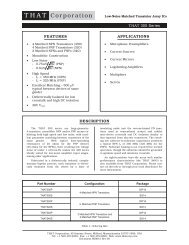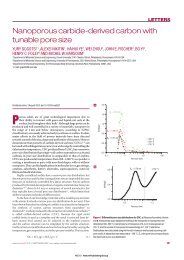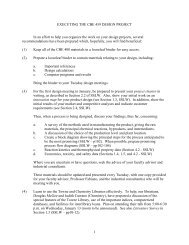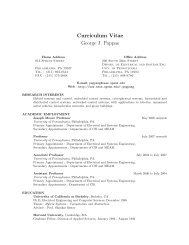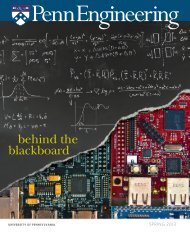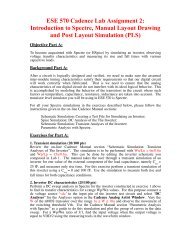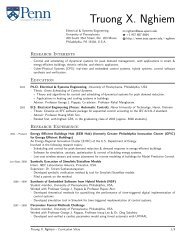articles - the School of Engineering and Applied Science - University ...
articles - the School of Engineering and Applied Science - University ...
articles - the School of Engineering and Applied Science - University ...
Create successful ePaper yourself
Turn your PDF publications into a flip-book with our unique Google optimized e-Paper software.
ARTICLES<br />
On <strong>the</strong> o<strong>the</strong>r h<strong>and</strong>, for <strong>the</strong> pre-assembled cases, <strong>the</strong> simulation system is constructed in a box by<br />
replicating a basic unit containing four polymer chains (two in <strong>the</strong> upper leaflet <strong>and</strong> two in <strong>the</strong> lower<br />
leaflet) with sufficient CG water W sites. Polymer chains are placed in such a way that <strong>the</strong> hydrophobic<br />
tails face each o<strong>the</strong>r, while <strong>the</strong> hydrophilic parts are exposed to water. This system is allowed to relax <strong>and</strong><br />
equilibrate at 298.15 K. We <strong>the</strong>n replicated <strong>the</strong> simulation cell in <strong>the</strong> xy plane to generate polymer<br />
systems with, respectively 8, 16, 32, 64 <strong>and</strong> 128 polymers. After delicate adjustments to remove<br />
overlapping waters, <strong>the</strong> simulation systems resulted in <strong>the</strong> copolymer/water ratios presented in Table 1.<br />
In order to compare our simulation results with <strong>the</strong> experimental results, it is necessary to carry out<br />
MD simulations with constant surface area per polymer (A) that corresponds to zero tension. This is an<br />
important observation because <strong>the</strong> surface/interfacial tension <strong>of</strong> <strong>the</strong> system is very sensitive to <strong>the</strong><br />
quantity A <strong>and</strong> can vary over an order <strong>of</strong> magnitude by moderately changing surface area. Hence, for this<br />
purpose we have chosen an N A PT ensemble. In this ensemble, <strong>the</strong> simulation box length in <strong>the</strong> x <strong>and</strong> y<br />
directions is fixed while it is allowed to vary in <strong>the</strong> z direction. As a result, <strong>the</strong> normal pressure in <strong>the</strong> z<br />
direction fluctuates around a mean (pressure) value, while keeping <strong>the</strong> surface area per polymer<br />
unchanged. More details in this regard are presented in <strong>the</strong> Supplementary Information.<br />
The simulation system in each case was allowed to relax <strong>and</strong> equilibrate at 298.15 K for 5 ns. For <strong>the</strong><br />
next 5 ns, <strong>the</strong> stability <strong>of</strong> <strong>the</strong> system was monitored. As mentioned in earlier studies, <strong>the</strong> CG approach<br />
involves larger size interacting sites <strong>and</strong> s<strong>of</strong>ter potentials, which essentially results in <strong>the</strong> timescales that<br />
are dilated by two orders <strong>of</strong> magnitude larger in comparison with <strong>the</strong> all-atom simulation times. All <strong>of</strong> <strong>the</strong><br />
times reported in this article are <strong>the</strong> actual CG simulation times, <strong>and</strong> not <strong>the</strong> effective simulation times,<br />
which are probably two orders <strong>of</strong> magnitude longer.<br />
Received 17 February 2004; accepted 17 June 2004; published 8 August 2004.<br />
References<br />
1. Discher, B. M. et al. Polymersomes: Tough vesicles made from diblock copolymers. <strong>Science</strong> 284,<br />
1143–1146 (1999).<br />
2. Cornelissen, J. L. M., Fisher, M., Sommerdijk, N. A. J. M. & Nolte R. J. M. Helical superstructures<br />
from charged poly(styrene)-poly(isocyanodipeptide) block copolymers. <strong>Science</strong> 280, 1427–1430<br />
(1998).<br />
3. Meier, W., Nardin, C. & Winterhalter, M. Reconstitution <strong>of</strong> channel proteins in (polymerized) ABA<br />
triblock copolymer membranes. Angew. Chem. Int. Edn 39, 4599–4602 (2000).<br />
4. Nardin, C., Widmer, J., Winterhalter, M. & Meier, W. Amphiphilic block copolymer nanocontainers as<br />
bioreactors. Eur.Phys.J.E4, 403–410 (2001).<br />
5. Okada, J., Cohen, S. & Langer, R. In-vitro evaluation <strong>of</strong> polymerized liposomesas an oral-drug delivery<br />
system. Pharmaceut. Res. 12, 576–582 (1995).<br />
6. Discher, D. E. & Eisenberg, A. Polymer vesicles. <strong>Science</strong> 297, 967–973 (2002).<br />
7. Hamley, I. W. Nanostructure fabrication using block copolymers. Nanotechnology 14, R39–R54<br />
(2003).<br />
8. Napoli, A. V., Valentini, M., Tirelli, N., Müller, M. & Hubbell, J. A. Oxidation-responsive polymeric<br />
vesicles. Nature Mater. 3, 183–189 (2004).<br />
9. Zhang, L. F. & Eisenberg, A. Multiple morphologies <strong>of</strong> crew-cut aggregates <strong>of</strong> polystyrene-Bpoly(acrylic<br />
acid) block-copolymers. <strong>Science</strong> 268, 1728–1731 (1995).<br />
10. Jain, S. & Bates, F. S. On <strong>the</strong> origins <strong>of</strong> morphological complexity in block copolymer surfactants.<br />
<strong>Science</strong> 300, 460–464 (2003).<br />
11. Tew, G. N. et al. De novo design <strong>of</strong> biomimetic antimicrobial polymers. Proc. Natl Acad. Sci. USA 99,<br />
5110–5114 (2002).<br />
12. Lipowsky R, & Sackman, E. (eds) Structure <strong>and</strong> Dynamics <strong>of</strong> Membranes (Elsevier, Amsterdem, 1995).<br />
13. Cevc, G. Phospholipids H<strong>and</strong>book (Marcel Decker, New York, 1993).<br />
14. Chakraborty, A. K. & Golumbfskie, A. J. Polymer adsorption driven self-assembly <strong>of</strong> nanostructures.<br />
Ann. Rev. Phys. Chem. 52, 537–573 (2001).<br />
15. Balsara, N. P., Garetz, B. A., Newstein, M. C., Bauer, B. J. & Prosa, T. J. Evolution <strong>of</strong> microstructure in<br />
<strong>the</strong> liquid <strong>and</strong> crystal directions in a quenched block copolymer melt. Macromolecules 31, 7668–7675<br />
(1998).<br />
16. Forster, S., Zisenis, M., Wenz, E. & Antonietti, M. Micellization <strong>of</strong> strongly segregated block<br />
copolymers. J. Chem. Phys. 104, 9956–9970 (1996).<br />
17. Needham, D. & Zhelev, D. V. The Mechanochemistry <strong>of</strong> Lipid Vesicles Examined by Micropipette<br />
Manipulation Techniques in Vesicles (ed. Ros<strong>of</strong>f, M.) Ch. 9 (Marcel Dekker, New York, 2000).<br />
18. Bermudez, H., Brannan, A. K., Hammer, D. A., Bates, F. S. & Discher, D. E. Molecular weight<br />
dependence <strong>of</strong> polymersome membrane structure, elasticity, <strong>and</strong> stability. Macromolecules 35,<br />
8203–8208 (2002).<br />
19. Hillmyer, M. A. & Bates, F. S. Syn<strong>the</strong>sis <strong>and</strong> characterization <strong>of</strong> model polyalkane-poly(ethylene<br />
oxide) block copolymers. Macromolecules 29, 6994–7002 (1996).<br />
20. Pakula, T., Karatasos, K., Anastasiadis, S. H. & Fytas, G. Computer simulation <strong>of</strong> static <strong>and</strong> dynamic<br />
behavior <strong>of</strong> diblock copolymer melts. Macromolecules 30, 8463–8472 (1997).<br />
21. Schultz, A. J., Hall, C. K. & Genzer, J. Computer simulation <strong>of</strong> copolymer phase behavior. J. Chem. Phys.<br />
117, 10329–10338 (2002).<br />
22. Pastor, R. W., Venable, R. M., Karplus, M. & Szabo, A. A simulation based model <strong>of</strong> nmr T1 relaxation<br />
in lipid bilayer vesicles. J. Chem. Phys. 89, 1128–1140 (1988).<br />
23. Noguchi, H. & Takasu, M. Fusion pathways <strong>of</strong> vesicles: A Brownian dynamics simulation. J. Chem. Phys.<br />
115, 9547–9551 (2001).<br />
24. Noguchi, H. Fusion <strong>and</strong> toroidal formation <strong>of</strong> vesicles by mechanical forces: A Brownian dynamics<br />
simulation. J. Chem. Phys. 117, 8130–8137 (2002).<br />
25. Srinivas, G. & Bagchi, B. Detection <strong>of</strong> collapsed <strong>and</strong> ordered polymer structures by fluorescence<br />
resonance energy transfer in stiff homopolymers: Bimodality in <strong>the</strong> reaction efficiency distribution.<br />
J. Chem. Phys. 116, 837–844 (2002).<br />
26. Smit, B. et al. Structure <strong>of</strong> a water/oil interface in <strong>the</strong> presence <strong>of</strong> micelles: a computer simulation<br />
study. J. Phys. Chem. 95, 6361–6368 (1991).<br />
27. Goetz, R., Gompper, G. & Lipowsky, R. Mobility <strong>and</strong> elasticity <strong>of</strong> self-assembled membranes.<br />
Phys.Rev.Lett.82, 221–224 (1999).<br />
28. Shelley, J. C., Shelley, M. Y., Reeder, R. C., B<strong>and</strong>yopadhyay, S. & Klein, M. L. A coarse grain model for<br />
phospholipid simulations. J. Phys. Chem. B 105, 4464–4470 (2001).<br />
29. Tieleman, D. P. & Marrink, S. J. Potential <strong>of</strong> mean force <strong>of</strong> a lipid in a lipid bilayer. Biophys. J. 84,<br />
368–369 (2003).<br />
30. Tieleman, D. P., Leontiadou, H., Mark, A. E. & Marrink, S. J. Simulation <strong>of</strong> pore formation in lipid<br />
bilayers by mechanical stress <strong>and</strong> electric fields. J. Am. Chem. Soc. 125, 6382–6383 (2003).<br />
31. Marrink, S. J. & Tieleman, D. P. Molecular dynamics simulation <strong>of</strong> a lipid diamond cubic phase.<br />
J. Am. Chem. Soc. 123, 12383–12391 (2001).<br />
32. Marrink, S. J., Lindahl, E., Edholm, O. & Mark, A. E. Simulation <strong>of</strong> <strong>the</strong> spontaneous aggregation <strong>of</strong><br />
phospholipids into bilayers. J. Am. Chem. Soc. 123, 8638–8639 (2001).<br />
33. Marrink, S. J. & Mark, A. E. Effect <strong>of</strong> undulations on surface tension in simulated bilayers. J. Phys.<br />
Chem. B 105, 6122–6127 (2001).<br />
34. Marrink, S. J. & Mark, A. E. Molecular dynamics simulation <strong>of</strong> <strong>the</strong> formation, structure, <strong>and</strong><br />
dynamics <strong>of</strong> small phospholipid vesicles. J. Am. Chem. Soc. 125, 15233–15242 (2003).<br />
35. Nielsen, S. O. & Klein, M. L. Bridging Time Scales: Molecular Simulations for <strong>the</strong> Next Decade (eds<br />
Nielaba, P., Mareschali, M. <strong>and</strong> Ciccotti, G.) 27–63 (Elsevier <strong>Science</strong>, Amsterdam, 2003).<br />
36. Shelley, J. C. et al. Simulations <strong>of</strong> phospholipids using a coarse grain model. J. Phys. Chem. B 105,<br />
9785–9792 (2001).<br />
37. Nielsen, S. O., Lopez, C. F., Moore, P. B., Shelley, J. C. & Klein, M. L. Molecular dynamics<br />
investigations <strong>of</strong> lipid langmuir monolayers using a coarse-grain model. J. Phys. Chem. B 107,<br />
13911–13917 (2003).<br />
38. Srinivas, G., Shelley, J. C., Nielsen, S. O., Discher, D. E. & Klein, M. L. Simulation <strong>of</strong> diblock<br />
copolymer self-assembly using a coarse-grain model. J. Phys. Chem. B 108, 8153–8160 (2004).<br />
39. Lindahl, E. & Edholm, O. Spatial <strong>and</strong> energetic-entropic decomposition <strong>of</strong> surface tension in lipid<br />
bilayers from molecular dynamics simulations. J. Chem. Phys. 113, 3882–3893 (2000).<br />
40. Feller, S. E., Zhang, Y. H. & Pastor, R. W. Computer-simulation <strong>of</strong> liquid/liquid interfaces. 2. Surfacetension<br />
area dependence <strong>of</strong> a bilayer <strong>and</strong> monolayer. J. Chem. Phys. 103, 10267–10276 (1995).<br />
41. Feller, S. E. & Pastor, R. W. Constant surface tension simulations <strong>of</strong> lipid bilayers: The sensitivity <strong>of</strong><br />
surface areas <strong>and</strong> compressibilities. J. Chem. Phys. 111, 1281–1287 (1999).<br />
42. Goetz, R. & Lipowsky, R. Computer simulations <strong>of</strong> bilayer membranes: self-assembly <strong>and</strong> interfacial<br />
tension. J. Chem. Phys. 108, 7397–7409 (1998).<br />
43. Rao, M. & Levesque, D. Surface structure <strong>of</strong> a liquid film. J. Chem. Phys. 65, 3233–3236 (1976).<br />
44. Bermudez, H., Hammer, D. A. & Discher, D. E. Effect <strong>of</strong> bilayer thickness on membrane bending<br />
rigidity. Langmuir 20, 540–543 (2004).<br />
45. Israelachvili, J. N. Intermolecular <strong>and</strong> Surface Forces (Academic, San Diego, California, 1998).<br />
46. Mark, J. E. Physical Properties <strong>of</strong> Polymers H<strong>and</strong>book (AIP Series in Polymers <strong>and</strong> Complex Materials,<br />
AIP, New York, 1996).<br />
47. Lee, J. C. M., Law, R. J. & Discher, D. E. Bending contributions hydration <strong>of</strong> phospholipid <strong>and</strong> block<br />
copolymer membranes: Unifying correlations between probe fluorescence <strong>and</strong> vesicle<br />
<strong>the</strong>rmoelasticity. Langmuir 17, 3592–3597 (2001).<br />
48. Lee, J. C. M., Santore, M., Bates, F. S. & Discher, D. E. From membranes to melts, rouse to reptation:<br />
Diffusion in polymersome versus lipid bilayers. Macromolecules 35, 323–326 (2002).<br />
Acknowledgements<br />
We would like to thank John C. Shelley, Carlos Lopez, Steve Nielsen, Ivaylo Ivanov <strong>and</strong> Preston B. Moore.<br />
This work has been supported by <strong>the</strong> National <strong>Science</strong> Foundation (Pennsylvania <strong>University</strong>’s Materials<br />
Research <strong>Science</strong> <strong>and</strong> <strong>Engineering</strong> Centre) <strong>and</strong> <strong>the</strong> National Institutes <strong>of</strong> Health.<br />
Correspondence <strong>and</strong> requests for materials should be addressed to M.L.K.<br />
Supplementary Information accompanies <strong>the</strong> paper on www.nature.com/naturematerials<br />
Competing financial interests<br />
The authors declare that <strong>the</strong>y have no competing financial interests.<br />
nature materials | ADVANCE ONLINE PUBLICATION | www.nature.com/naturematerials 7<br />
© 2004 Nature Publishing Group



